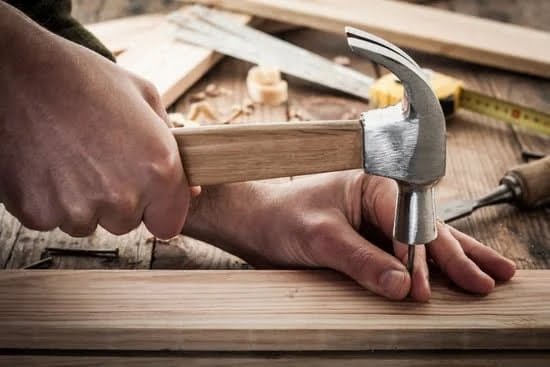Woodworking is a captivating hobby that has captured the attention and imagination of people all over the world. The process of transforming raw wood into beautiful, functional objects is a skill that has been passed down through generations. Whether you’re interested in building furniture, crafting intricate wooden sculptures, or simply working with your hands, woodworking offers endless possibilities for creativity and self-expression.
One common question that arises when starting out in woodworking is: How long does it take to learn this craft? The answer to this question varies depending on individual factors such as prior experience, time commitment, and personal goals. In this article, we will explore the fascinating world of woodworking and provide insights into the learning process for beginners.
To understand the basics of woodworking, it’s essential to define what exactly it entails. Woodworking encompasses a wide range of skills and techniques such as carpentry, joinery, woodturning, and more. It involves not only knowing how to use various tools but also understanding wood properties and being able to visualize and execute designs effectively.
Before jumping into woodworking headfirst, it’s important to assess your personal interest and goals in order to set realistic expectations. Reflecting on why you want to delve into this craft and what you hope to achieve will guide your learning journey. Additionally, being aware of the potential challenges as a beginner will help you persevere through initial setbacks and gain confidence in your skills.
As you embark on your woodworking journey, keep in mind that mastering this craft takes time and patience. Building foundational skills such as understanding wood properties, practicing basic cuts, mastering joinery techniques, and perfecting finishing methods is crucial. It’s important to remember that mistakes are part of the learning process so embrace them as opportunities for growth.
In the next sections of this article, we will delve deeper into these foundational steps of learning woodworking as well as explore different resources available for beginners. We will also discuss factors that affect learning speed and provide strategies and tips to accelerate your progress. So, if you are ready to embark on a fulfilling woodworking journey, let’s dive into the fascinating world of woodworking together.
Understanding the Basics
Woodworking is a versatile and rewarding craft that allows individuals to create beautiful and functional objects using wood. Before delving into the world of woodworking, it is important to understand what it entails and the various areas it covers. Woodworking includes practices such as carpentry, joinery, woodturning, and more.
Carpentry is perhaps the most well-known aspect of woodworking, involving the construction of structures and items such as cabinets and furniture. Joinery focuses on creating strong connections between pieces of wood, using techniques like mortise and tenon joints. Woodturning, on the other hand, involves shaping wood with a lathe to create pieces such as bowls or spindle legs.
To begin understanding woodworking, it is crucial to familiarize yourself with the tools and equipment commonly used in this craft. These may include hand tools like chisels, planes, saws, squares, and measuring devices. Power tools such as drills, routers, sanders, and table saws are also commonly used in woodworking projects.
| Woodworking Categories | Description |
|---|---|
| Carpentry | Involves construction of structures or items like furniture |
| Joinery | Focuses on creating strong connections between pieces of wood |
| Woodturning | Involves shaping wood using a lathe to create various objects |
Once you have a basic understanding of woodworking categories and tools, you can start exploring different techniques within these categories based on your interests. Whether your goal is to build intricate furniture or turn stunning wooden bowls, having a solid foundation in woodworking fundamentals is essential.
Assessing Personal Interest and Goals
When considering learning woodworking, it is essential to assess your personal interest and goals before diving into this fascinating hobby. Woodworking requires a certain level of commitment and dedication, but the rewards are well worth the effort. By reflecting on your motivation and level of interest, you can set yourself up for success in mastering this craft.
Motivation and Interests
Before embarking on your woodworking journey, take some time to think about what fuels your interest in this craft. Are you drawn to the creativity and artistry of woodworking? Do you have a desire to build functional pieces for your home or as gifts for loved ones? Understanding your motivations can help you stay focused and committed throughout the learning process.
It’s also important to consider your specific interests within woodworking. There are various areas within woodworking, such as carpentry, joinery, woodturning, and more. Each area has its unique techniques and tools. Think about what aspects of woodworking excite you the most, whether it’s building furniture, creating intricate woodturning projects, or experimenting with different joinery methods.
Setting Realistic Goals
Once you have assessed your interests, it’s time to set realistic goals for yourself in learning woodworking. It’s important not to overwhelm yourself by trying to tackle too much too soon. Instead, break down your goals into manageable steps that align with your current skill level.
Consider starting with small projects that allow you to practice essential skills and gradually progress towards more complex projects. This approach builds confidence and provides a sense of accomplishment as you see yourself improving over time. Remember that learning woodworking is a continuous journey, so be patient with yourself and enjoy the process of acquiring new skills.
By assessing your personal interests and setting realistic goals in woodworking, you lay a solid foundation for success in this craft. Keep in mind that everyone learns at their own pace, and the learning process is as unique as each individual. Embrace the journey and enjoy the fulfillment that comes from creating with wood.
Learning Curve
Overcoming Initial Challenges
When starting out in woodworking, it is important to remember that everyone has a learning curve. As a beginner, it is natural to face challenges and make mistakes along the way. The key is to embrace these challenges as learning opportunities and not get discouraged. By understanding some common struggles that beginners face and how to overcome them, you can build confidence in your woodworking skills.
One of the first challenges beginners often encounter is getting familiar with the various tools and equipment used in woodworking. It may take some time to understand how each tool works and how to use them safely. Take the time to read manuals, watch instructional videos, or seek guidance from experienced woodworkers. Practice using the tools on scrap wood before working on your actual projects to gain confidence and improve your skills.
Additionally, measurement and accuracy are crucial aspects of woodworking. It can be frustrating when cuts or joinery do not fit perfectly together, but this is part of the learning process. Pay close attention to measurements, utilize marking techniques for precision, and double-check your work before making any irreversible cuts. Remember that mistakes are normal at first, so learn from them and refine your techniques as you progress.
Progressing Through Different Skill Levels
As a beginner, it’s important to start with simple projects that align with your current skill level. This allows you to gradually develop your woodworking skills while gaining confidence along the way. Once you feel comfortable with basic cuts and joinery techniques, you can move on to more complex projects.
With each project completed, you will find yourself advancing through different skill levels. Woodworking requires practice and patience in order to improve craftsmanship. Embrace continuous learning by seeking feedback from experienced woodworkers or taking classes where you can learn new techniques and refine existing ones.
It’s important to remember that mastery in woodworking takes time. Don’t rush the process or become frustrated if you feel like progress is slow. Focus on enjoying the journey and celebrating small victories. By staying dedicated, practicing regularly, and continually challenging yourself with new projects, you will gradually develop your woodworking skills and reach higher levels of craftsmanship. Remember, even the most skilled woodworkers started as beginners too.
Essential Steps in Learning Woodworking
Woodworking is a skill that requires a solid foundation of knowledge and practice. Whether you’re interested in making furniture, carving intricate designs, or crafting functional items, mastering the essential steps of woodworking is crucial. Here are some key steps to consider on your journey to becoming a skilled woodworker:
- Understand Wood Properties: One of the first steps in learning woodworking is understanding the properties of different types of wood. Each wood species has unique characteristics in terms of grain patterns, hardness, and stability. Familiarize yourself with these properties to make informed decisions when selecting materials for your projects.
- Practice Basic Cuts: Learning how to make accurate cuts is essential in woodworking. Start by practicing basic cuts such as crosscuts, rip cuts, bevel cuts, and miter cuts. These foundational skills will serve as building blocks for more complex woodworking techniques.
- Learn Joinery Techniques: Joinery involves joining two or more pieces of wood together to form strong and sturdy connections. Understanding different joinery techniques like butt joints, dado joints, mortise and tenon joints, and dovetail joints will expand your range of woodworking possibilities.
- Master Finishing Methods: A well-executed finish can enhance the beauty and durability of your woodworking projects. Explore different finishing methods such as staining, varnishing, painting, or applying natural oils to protect and bring out the natural grain of the wood.
Remember that mastering woodworking takes time and patience. It’s important to start small and gradually build up your skills as you gain confidence throughout each step of the process. Don’t be discouraged by mistakes along the way; they offer valuable learning opportunities for improvement.
To aid you in your learning journey, there are numerous resources available. Books on woodworking offer detailed instructions and design inspiration, while online tutorials provide visual demonstrations and step-by-step guides. Additionally, consider attending local woodworking classes or workshops where you can learn from experienced artisans and interact with fellow enthusiasts.
As you progress in your woodworking skills, you may find it beneficial to invest in essential tools. Basic tools such as a table saw, miter saw, chisels, and clamps will assist in completing various woodworking tasks. When selecting tools, be mindful of your specific woodworking interests and budget.
By following these essential steps and utilizing the available resources and tools, you’ll be well on your way to becoming a skilled woodworker. Remember to have patience, practice regularly, and embrace continuous improvement. Woodworking is not just a craft-it’s a journey that offers endless possibilities for creativity and personal fulfillment. So grab your tools, unleash your imagination, and embark on the exciting path of mastering woodworking.
Learning Resources and Tools
When it comes to learning woodworking, having access to the right resources and tools can greatly enhance the learning experience. Whether you prefer hands-on learning or exploring online tutorials, there are a variety of options available for aspiring woodworkers. Additionally, investing in the essential tools and equipment will provide a solid foundation for your woodworking journey.
Learning Resources
Woodworking offers a wide range of learning resources to suit different preferences and budgets. For those who prefer books, there are countless titles available that cover everything from basic techniques to advanced projects. Some recommended books for beginners include “The Complete Manual of Woodworking” by Albert Jackson and David Day, and “Understanding Wood: A Craftsman’s Guide to Wood Technology” by Bruce Hoadley.
For those who prefer visual instruction, online tutorials and videos can be an excellent way to learn woodworking at your own pace. Websites like YouTube offer a wealth of free content from experienced woodworkers who generously share their knowledge and expertise. Additionally, there are paid online courses that provide structured lessons and step-by-step guidance.
If you prefer more hands-on learning, consider enrolling in a woodworking class or workshop. These opportunities allow you to learn from experienced instructors and interact with other passionate woodworkers. Many community centers, trade schools, and woodworking clubs offer classes tailored for beginners.
Essential Tools and Equipment
Before diving into the world of woodworking, it is important to have the right tools at your disposal. While the specific tools needed will depend on your woodworking goals and interests, there are some essentials that every beginner should consider:
- Workbench: A sturdy workbench provides a stable surface for cutting, drilling, sanding, and assembling your projects.
- Hand Tools: Basic hand tools such as saws, chisels, planes, hammers, screwdrivers, and clamps are necessary for most woodworking tasks.
- Power Tools: Depending on your projects, you may want to invest in power tools such as a circular saw, drill, jigsaw, or router.
- Measuring and Marking Tools: Accurate measurements are crucial in woodworking, so having tools like a tape measure, combination square, marking gauge, and a level is essential.
- Safety Equipment: Ensuring your safety is paramount, so investing in safety goggles, ear protection, dust masks, and gloves is highly recommended.
By utilizing these learning resources and acquiring the necessary tools and equipment, you will be well-prepared to embark on your woodworking journey. Remember that learning woodworking takes time and practice, but with dedication and the right resources at your disposal, you will be well on your way to mastering this fascinating craft.
Time Investment
Learning woodworking is an exciting endeavor, but one question that arises for many beginners is, “How long does it take to learn woodworking?” The answer greatly depends on various factors that can influence the learning speed. Understanding these factors can help individuals set realistic expectations and effectively plan their woodworking journey.
- Prior experience or related skills: Previous experience with woodworking or related skills such as carpentry or craftsmanship can significantly shorten the learning curve. Those who are already familiar with tools and basic concepts may find it easier to grasp new techniques and concepts in woodworking.
- Time availability for practice: Like any skill, woodworking requires consistent practice to improve. The more time individuals devote to practicing and honing their skills, the faster they are likely to progress. It’s important to set aside dedicated time on a regular basis to work on projects and practice different woodworking techniques.
- Dedication to learning: The level of dedication and commitment an individual has towards learning woodworking plays a significant role in the speed of progress. Those who are passionate about honing their craft and consistently seek opportunities for growth tend to learn faster compared to those who approach it casually.
It is worth noting that while these factors can impact the learning speed, there is no set timeframe for becoming a proficient woodworker. Learning woodworking is a continuous journey, and each person progresses at their own pace. It’s essential not to compare oneself to others but instead focus on personal progress and enjoyment of the process.
Regardless of the factors affecting learning speed, there are some effective strategies that can help maximize the time invested in acquiring woodworking skills. Setting small achievable goals allows beginners to gain confidence through accomplishing milestones along the way. Seeking feedback from experienced woodworkers or even joining a mentorship program can provide valuable guidance and accelerate learning. Embracing continuous improvement, experimenting with new techniques, and learning from mistakes are also crucial aspects of the woodworking journey.
Learning Strategies and Tips
When embarking on the journey of learning woodworking, it is important to have effective learning strategies and tips in place. The process can be both challenging and rewarding, but with the right approach, beginners can accelerate their progress and achieve mastery in woodworking.
One essential strategy for accelerating the learning process is setting small achievable goals. Rather than overwhelming yourself with complex projects from the start, focus on mastering one specific skill at a time. This could be learning how to make basic cuts or practicing different joinery techniques. By breaking down the learning process into manageable steps, you will build a strong foundation of skills and gradually progress towards more advanced projects.
Seeking feedback and mentorship is another valuable tip for enhancing your woodworking journey. Feedback from experienced woodworkers or even fellow beginners can provide invaluable guidance and help identify areas for improvement. Additionally, finding a mentor who can share their knowledge and offer personalized advice can greatly enhance your learning experience. Joining local woodworking groups or online forums allows you to connect with like-minded individuals who can offer support and guidance along your journey.
Embracing continuous improvement is a mindset that can significantly boost your growth as a woodworker. Look at each project as an opportunity to learn something new, whether it’s experimenting with a different finishing technique or exploring innovative designs. Reflect on your successes and failures in order to learn from them and refine your skills further. By continually pushing yourself to improve, you will steadily advance in your woodworking abilities.
Conclusion
In conclusion, learning woodworking is a fascinating journey that requires dedication, patience, and a genuine interest in the craft. As we have explored throughout this article, understanding the basics of woodworking and assessing personal interest and goals are essential first steps.
From there, beginners can expect a learning curve filled with challenges and opportunities for growth. By breaking down the fundamental steps involved in mastering woodworking skills and utilizing various learning resources and tools, aspiring woodworkers can set themselves up for success.
It is important to remember that the time it takes to learn woodworking will vary from individual to individual. Factors such as prior experience or related skills, available practice time, and dedication to learning all play a role in determining the speed of progress. However, by establishing realistic goals, effectively managing time, and embracing continuous improvement through feedback and mentorship, individuals can accelerate their learning process.
Ultimately, embarking on the journey of woodworking mastery should be seen as an enjoyable pursuit that allows for creativity and self-expression. The fulfillment and reward that come from creating something with your own hands using wood cannot be understated.
So whether you are interested in creating intricate joinery pieces or simply want to build your own furniture, embrace the journey ahead with enthusiasm and passion. Woodworking is indeed a lifelong skill that brings joy at every step of the way.
Frequently Asked Questions
Can I teach myself woodworking?
Yes, it is definitely possible to teach yourself woodworking. With the abundance of online resources, instructional videos, and forums dedicated to woodworking, you can acquire the necessary knowledge and skills on your own.
It may require some trial and error, patience, and perseverance, but with a passion for the craft and a willingness to learn from mistakes, you can become proficient in woodworking. Starting with basic projects and gradually advancing to more complex ones will help you gain experience and develop your woodworking abilities.
Is woodworking a high income skill?
Woodworking has the potential to be a high income skill, but it largely depends on various factors such as market demand, your level of expertise, your ability to market your products or services, and the quality of your workmanship. Some woodworkers are able to earn a substantial income by selling custom-made furniture or unique wooden pieces that are highly sought after.
However, it should be noted that building up a clientele or establishing a brand take time and effort. It is important to continuously improve your skills over time and find ways to differentiate yourself from competitors in order to potentially command higher prices for your work.
Is woodworking as a hobby worth it?
Woodworking as a hobby can be highly rewarding and worth every minute invested in it. Engaging in woodworking allows you to unleash creativity by bringing ideas into reality through hands-on craftsmanship. Working with wood provides a sense of fulfillment as you see tangible results from your efforts.
Additionally, it offers an opportunity for relaxation and stress relief as you immerse yourself in the process of creating something with your own hands. Whether making small home décor items or larger furniture pieces, woodworking as a hobby allows you to constantly challenge yourself while developing new skills and knowledge about different types of wood and techniques involved in their manipulation. While there may be costs associated with tools and materials initially, many find that the joy derived from pursuing woodworking as a hobby far outweighs any financial investments made along the way

Hi everyone! I’m a woodworker and blogger, and this is my woodworking blog. In my blog, I share tips and tricks for woodworkers of all skill levels, as well as project ideas that you can try yourself.





